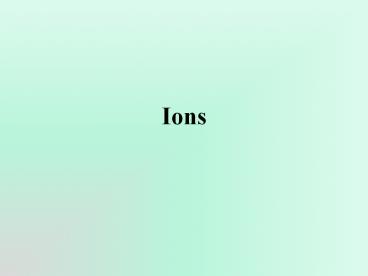Ions - PowerPoint PPT Presentation
Title:
Ions
Description:
Predictable Metal Ions, Unpredictable Transition Metal Ions, and Nonmetal Ions ... (using the word ion is redundant and not acceptable when naming nonmetal ions) The ... – PowerPoint PPT presentation
Number of Views:34
Avg rating:3.0/5.0
Title: Ions
1
Ions
2
Ions
- atoms of a given element that
- differ in the number of electrons,
and consequently in overall charge.
3
Ions
- periodic patterns regarding ions
4
Ions
- metal ions vs. nonmetal ions
5
Working with Atomic Notation
- AZX
Ionic Charge or Oxidation Number
Chemical Symbol
6
Working with Atomic Notation
Cl
-1
35
17
7
Working with Ionic Notation
- Cl -1
8
Working with Atomic Notation
- 2311 Na 1
9
Working with Ionic Notation
- Na 1
10
Ions
- Anion
- Negatively charged ion.
- Cation
- Positively charged ion.
11
(No Transcript)
12
6 C Carbon 12.011
neutral Carbon
ionic Carbon
of p
of no
of e-
of p
of no
of e-
13
3 Li Lithium 6.941
neutral Lithium
ionic Lithium
of p
of no
of e-
of p
of no
of e-
14
17 Cl Chlorine 34.453
Chlorinethe neutral atom
Chlorinethe ion
of p
of no
of e-
of p
of no
of e-
15
11 Na Sodium 22.990
Sodiumthe neutral atom
Sodiumthe ion
of p
of no
of e-
of p
of no
of e-
16
Octet Rule
- The octet rule says that atoms tend to gain, lose
or share electrons so as to have eight electrons
in their outer electron shell.
17
Transition Metal Ions
- Transition Metal Ions are different than other
metal ions.
Yes, they are all positive but
1) There are no predictable patterns that can be
used to determine their ionic charges
2) A good number of transition metal elements
possess an ability to have more than one positive
ion.
18
1) There are no predictable patterns that can be
used to determine their ionic charges
19
1) There are no predictable patterns that can be
used to determine their ionic charges
Co 2
Mn 7
Fe 2
20
1) There are no predictable patterns that can be
used to determine their ionic charges
Cu 2
Ag 1
21
2) A good number of transition metal elements
possess an ability to have more than one positive
ion.
Fe 3
Fe 2
22
2) A good number of transition metal elements
possess an ability to have more than one positive
ion.
Al 3
23
2) A good number of transition metal elements
possess an ability to have more than one positive
ion.
Mn 4
Mn 5
Mn 3
Mn2
Mn 7
24
Working with Ions (practice)
atomic (ionic) notation of p of e- of no
Ca o
Ca 2
N o
N -3
25
Working with more Ions (practice)
name atomic (ionic) notation of p of e- of no
the ion of magnesium
the ion of oxygen
the ion of fluorine
the ion of lithium
26
Review problemDraw the following ions and
(neutral) atoms using the Octet Rule/Model of the
atom. (Valence Shell Only)
a) Ne o
b) Mg 2
c) Na 1
d) N -3
27
Working with Ions (more practice)
atomic (ionic) notation of p of e- of no
K o
K 1
I o
I -1
28
Naming Ions
- Predictable Metal Ions, Unpredictable Transition
Metal Ions, and Nonmetal Ions - are named differently
29
Naming Ions
30
Naming Ions
- metal ions vs. nonmetal ions
keep the atoms elemental name add the word ion
keep the atoms elemental root drop the
ending add the suffix ide. (using the word
ion is redundant and not acceptable when naming
nonmetal ions)
31
Naming Transition Metal Ions
-Use the complete elemental name (as
expected). -Use roman numerals to designate the
ionic charge or oxidation number of the
transition metal ion. -Use the word ion to
designate its ionic nature.
- The
- Stock System
32
Transition Metal Ions
- Cu 2 ____________
- Mn 5 ____________
- Mn 7 ____________
Fe 2 ____________ Fe 3 ____________ Cu 1
____________
33
Naming Review
- Mg 2 ____________
- Ni 2 ____________
- Li 1 ____________
He _____________ F -1 _____________ O -2
_____________































